The bellow vacuum suction cup market is set to grow from USD 216.8 million in 2025 to USD 285.8 million by 2035, supported by the steady expansion of automated production lines and robotic handling systems. In many factories today, these cups are the quiet, unnoticed workers: gripping sheet metal panels, placing electronic components, or lifting packaged goods from conveyor to pallet. The first growth wave (2025–2030), adding USD 25.4 million, comes from manufacturers replacing traditional mechanical grippers with flexible bellow designs that adapt to uneven or curved surfaces. By the second phase (2030–2035), the market adds another USD 43.6 million, as smart, sensor-ready suction cups become common in connected factory environments.
Nitrile-based designs hold the largest share, about 56%, because they handle oils, heat, and abrasion common in automotive and heavy industry. Silicone variants follow with growing roles in electronics and food packaging, where softness and cleanliness matter. The automotive sector remains the anchor of demand, though electronics assembly, warehouse automation, and e-commerce packaging are expanding quickly. Key players shaping the field include Schmalz, Piab, SMC, Coval, and FIPA, each pushing better materials, longer life cycles, faster changeovers, and smoother integration with robots.
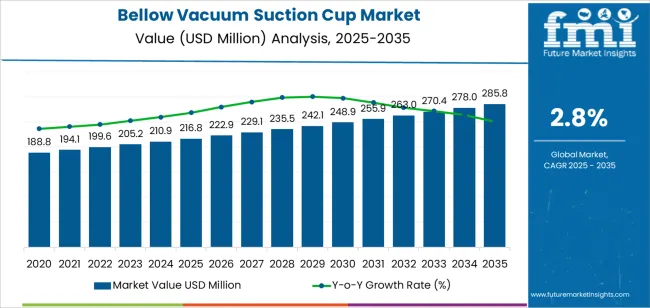
The latter half covering 2030-2035 will witness continued growth from USD 242.2 million to USD 285.8 million, representing an addition of USD 43.6 million or 63% of the decade's expansion. This period will be defined by mass market penetration of advanced bellow designs, integration with robotic systems, and seamless compatibility with existing automation infrastructure. The market trajectory signals fundamental shifts in how manufacturing facilities approach material handling and automation optimization, with participants positioned to benefit from growing demand across multiple material types and application segments. Geographic patterns indicate concentrated adoption in manufacturing-intensive regions with established automation infrastructure, while emerging markets demonstrate accelerating growth rates driven by industrial modernization initiatives and automation adoption programs across manufacturing and logistics facilities.
Where revenue comes from - now vs next (industry-level view)
| Period | Primary Revenue Buckets | Share | Notes |
|---|---|---|---|
| Today | Standard suction cup sales | 42% | Replacement-driven, OEM partnerships |
| Custom application solutions | 28% | Tailored designs, specialized materials | |
| Spare parts & accessories | 18% | Replacement bellows, mounting adapters | |
| Integration & installation services | 12% | System design, application engineering | |
| Future (3-5 yrs) | Advanced material solutions | 35-40% | High-performance compounds, specialized coatings |
| Application-specific systems | 25-30% | Industry-vertical solutions, turnkey packages | |
| IoT-enabled smart cups | 15-18% | Sensor integration, predictive maintenance | |
| Replacement & consumables | 12-15% | Lifecycle management, subscription models | |
| Engineering & consulting | 10-12% | Application optimization, performance analysis | |
| Digital services | 5-8% | Remote monitoring, performance analytics |
At-a-Glance Metrics
| Metric | Value |
|---|---|
| Market Value (2025) | USD 216.8 million |
| Market Forecast (2035) | USD 285.8 million |
| Growth Rate | 2.8% CAGR |
| Leading Material Type | Nitrile Suction Cup |
| Primary Application | Automotive |
The market demonstrates stable fundamentals with nitrile suction cups capturing dominant share through superior durability characteristics and automotive manufacturing optimization. Automotive applications drive primary demand, supported by increasing production automation and assembly line efficiency requirements. Geographic expansion remains concentrated in developed markets with established manufacturing infrastructure, while emerging economies show accelerating adoption rates driven by industrial automation initiatives and rising quality standards. The market benefits from ongoing transition toward flexible manufacturing systems requiring versatile vacuum handling solutions capable of managing diverse product geometries and surface characteristics across automated production environments.
Primary Classification: The market segments by material type into nitrile suction cup, silicone suction cup, and others, representing the evolution from standard rubber compounds to specialized material solutions for comprehensive industrial handling optimization.
Secondary Classification: Application segmentation divides the market into automotive, electronics, packaging, and others, reflecting distinct requirements for handling precision, surface compatibility, and operational reliability standards.
Regional Classification: Geographic distribution covers North America, Latin America, Western Europe, Eastern Europe, East Asia, South Asia Pacific, and Middle East & Africa, with developed markets leading adoption while emerging economies show accelerating growth patterns driven by industrial automation expansion programs.
The segmentation structure reveals material progression from conventional rubber formulations toward specialized compounds with enhanced performance characteristics, while application diversity spans from automotive assembly to electronics manufacturing requiring precise vacuum handling solutions.
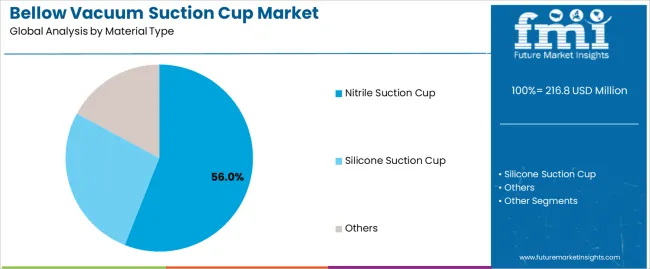
Market Position: Nitrile Suction Cup systems command the leading position in the bellow vacuum suction cup market with 56% market share through advanced durability features, including superior abrasion resistance, chemical compatibility, and automotive manufacturing optimization that enable handling systems to achieve optimal gripping performance across diverse industrial and manufacturing environments.
Value Drivers: The segment benefits from manufacturing facility preference for reliable handling systems that provide consistent gripping performance, extended operational life, and cost efficiency optimization without requiring frequent replacement intervals. Advanced material properties enable oil resistance, temperature stability, and integration with existing automation equipment, where operational reliability and material compatibility represent critical facility requirements.
Competitive Advantages: Nitrile Suction Cup systems differentiate through proven durability characteristics, consistent handling performance, and integration with automated manufacturing systems that enhance facility effectiveness while maintaining optimal gripping standards suitable for diverse automotive and industrial applications.
Key market characteristics:
Silicone Suction Cup systems maintain a 32% market position in the bellow vacuum suction cup market due to their flexibility properties and temperature advantages. These systems appeal to facilities requiring delicate surface handling with high-temperature resistance for electronics and food packaging applications. Market growth is driven by precision manufacturing expansion, emphasizing non-marking handling solutions and operational versatility through optimized material designs.
Others capture 12% market share through specialized handling requirements in extreme environment applications, custom compound formulations, and specialized surface compatibility scenarios. These facilities demand tailored suction solutions capable of handling unique material characteristics while providing effective gripping capabilities and chemical resistance.
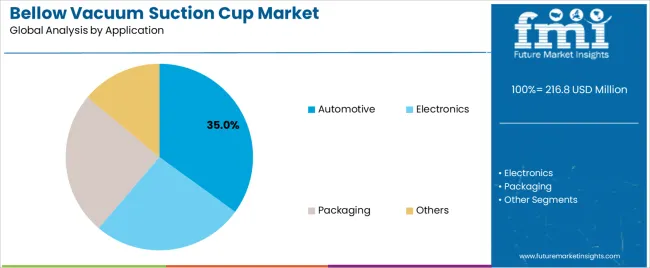
Market Context: Automotive applications accounts for 35% market share demonstrate the highest growth rate in the bellow vacuum suction cup market with 3.8% CAGR due to widespread adoption of automated assembly systems and increasing focus on production efficiency optimization, quality assurance, and manufacturing throughput applications that maximize automation effectiveness while maintaining handling precision standards.
Appeal Factors: Automotive operators prioritize system reliability, rapid cycle times, and integration with robotic assembly infrastructure that enables coordinated handling operations across multiple production stations. The segment benefits from substantial manufacturing investment and automation programs that emphasize the acquisition of advanced vacuum handling systems for production optimization and quality assurance applications.
Growth Drivers: Automotive electrification programs incorporate advanced handling systems as standard equipment for battery assembly and component handling operations, while lightweighting trends increase demand for precision gripping capabilities that prevent surface damage and minimize handling complexity.
Market Challenges: Varying component geometries and surface finish requirements may limit suction cup standardization across different vehicle platforms or assembly scenarios.
Application dynamics include:
Electronics applications capture market share through specialized handling requirements in circuit board assembly, component placement, and delicate surface applications. These facilities demand precision vacuum systems capable of operating with sensitive components while providing effective gripping access and non-marking reliability capabilities.
Packaging applications account for market share, including high-speed packaging lines, material handling automation, and logistics operations requiring versatile handling capabilities for operational optimization and production efficiency.
| Category | Factor | Impact | Why It Matters |
|---|---|---|---|
| Driver | Industrial automation acceleration & robotic deployment (labor cost pressures) | ★★★★★ | Automated systems require reliable vacuum gripping solutions with consistent performance and minimal maintenance across production cycles. |
| Driver | Electric vehicle manufacturing expansion (battery assembly automation) | ★★★★★ | Turns specialized handling from optional to mandatory; vendors offering delicate surface compatibility and precision gripping gain competitive advantage. |
| Driver | E-commerce growth & warehouse automation (logistics efficiency demands) | ★★★★☆ | Distribution centers need versatile handling systems; demand for multi-surface compatibility and quick changeover expanding addressable market. |
| Restraint | Material cost volatility & raw material availability (specialty compounds) | ★★★★☆ | Small manufacturers face margin pressures; increases price sensitivity and slows advanced material adoption in cost-conscious markets. |
| Restraint | Application complexity & engineering requirements (custom solutions) | ★★★☆☆ | Diverse handling scenarios require extensive application engineering and testing protocols, limiting standardization and increasing implementation complexity. |
| Trend | Smart sensing integration & condition monitoring (predictive maintenance) | ★★★★★ | Sensor-embedded suction cups with vacuum monitoring and wear detection transform operations; connectivity and diagnostic capabilities become core value propositions. |
| Trend | Sustainable materials & circular economy initiatives (recyclable compounds) | ★★★★☆ | Environmental responsibility drives demand for eco-friendly materials; platforms offering sustainable solutions and extended lifecycle drive competition toward responsible manufacturing practices. |
The bellow vacuum suction cup market demonstrates varied regional dynamics with Growth Leaders including China (3.8% growth rate) and India (3.5% growth rate) driving expansion through industrial automation initiatives and manufacturing capacity development. Steady Performers encompass Germany (3.2% growth rate), United States (2.7% growth rate), and developed regions, benefiting from established manufacturing industries and advanced automation adoption. Emerging Markets feature Brazil (2.9% growth rate) and developing regions, where industrial modernization and automation implementation support consistent growth patterns.
Regional synthesis reveals East Asian markets leading adoption through manufacturing expansion and automation development, while South Asian countries maintain strong growth supported by industrial infrastructure advancement and production capacity initiatives. North American markets show steady expansion driven by manufacturing reshoring and automation technology adoption, while European markets demonstrate moderate growth influenced by Industry 4.0 applications and manufacturing innovation trends.

| Region/Country | 2025-2035 Growth | How to win | What to watch out |
|---|---|---|---|
| China | 3.8% | Lead with cost-effective solutions | Price competition; local manufacturers |
| India | 3.5% | Focus on automotive applications | Infrastructure gaps; skilled labor availability |
| Germany | 3.2% | Offer premium engineering | Over-specification; lengthy approval cycles |
| Brazil | 2.9% | Provide value-oriented models | Currency fluctuations; import duties |
| United States | 2.7% | Push integration services | Market maturity; replacement cycle dependence |
| United Kingdom | 2.4% | Emphasize flexibility features | Manufacturing decline; Brexit impacts |
China establishes fastest market growth through aggressive industrial automation programs and comprehensive manufacturing technology development, integrating bellow vacuum suction cups as standard components in automotive assembly, electronics production, and packaging automation installations. The country's 3.8% growth rate reflects government initiatives promoting manufacturing upgrading and automation adoption that mandate the use of advanced handling systems in industrial and manufacturing facilities. Growth concentrates in major manufacturing hubs, including Guangdong, Jiangsu, and Zhejiang provinces, where automotive and electronics operations showcase integrated vacuum handling systems that appeal to manufacturers seeking advanced automation capabilities and production optimization applications.
Chinese manufacturers are developing cost-effective suction cup solutions that combine domestic production advantages with adequate performance features, including standard material formulations and basic automation compatibility. Distribution channels through industrial equipment suppliers and automation distributors expand market access, while government support for manufacturing modernization supports adoption across diverse automotive, electronics, and packaging segments.
Strategic Market Indicators:
In Mumbai, Chennai, and Pune, automotive facilities and electronics manufacturing plants are implementing bellow vacuum suction cups as standard equipment for production automation and handling optimization applications, driven by increasing government manufacturing investment and industrial modernization programs that emphasize the importance of automation capabilities. The market holds a 3.5% growth rate, supported by government Make in India initiatives and manufacturing infrastructure development programs that promote advanced handling systems for automotive and electronics facilities. Indian operators are adopting vacuum systems that provide reliable operational performance and cost-effective features, particularly appealing in urban regions where production efficiency and quality standards represent critical operational requirements.
Market expansion benefits from growing automotive manufacturing capabilities and electronics assembly development that enable domestic demand for vacuum handling systems for industrial applications. Technology adoption follows patterns established in automation equipment, where reliability and affordability drive procurement decisions and operational deployment.
Market Intelligence Brief:
Germany establishes technology leadership through comprehensive manufacturing programs and advanced industrial infrastructure development, integrating bellow vacuum suction cups across automotive and electronics manufacturing applications. The country's 3.2% growth rate reflects established automation industry relationships and mature handling technology adoption that supports widespread use of precision vacuum systems in manufacturing and assembly facilities. Growth concentrates in major industrial centers, including Baden-Württemberg, Bavaria, and North Rhine-Westphalia, where automotive operations showcase mature handling deployment that appeals to manufacturers seeking proven precision gripping capabilities and operational reliability applications.
German equipment providers leverage established distribution networks and comprehensive engineering capabilities, including application support programs and customization services that create customer relationships and operational advantages. The market benefits from mature automation standards and manufacturing requirements that support vacuum system use while encouraging technology advancement and operational optimization.
Market Intelligence Brief:

United States demonstrates market leadership through comprehensive manufacturing programs and advanced industrial infrastructure development, integrating bellow vacuum suction cups across automotive, electronics, and packaging applications. The country's 2.7% growth rate reflects established automation industry relationships and mature vacuum handling adoption that supports widespread use of gripping systems in manufacturing and logistics facilities. Growth concentrates in major industrial centers, including Michigan, Ohio, and California, where automotive and electronics operations showcase mature system deployment that appeals to manufacturers seeking proven handling capabilities and operational efficiency applications.
American equipment providers prioritize system reliability and application engineering in handling equipment development, creating demand for proven solutions with comprehensive support, including technical documentation and installation services. The market benefits from established automation infrastructure and willingness to invest in handling technologies that provide operational benefits and compliance with manufacturing standards.
Market Intelligence Brief:
Brazil's market expansion benefits from diverse manufacturing demand, including industrial modernization in São Paulo and Rio Grande do Sul, automotive facility upgrades, and government manufacturing programs that increasingly incorporate vacuum handling solutions for production optimization applications. The country maintains a 2.9% growth rate, driven by rising automotive activity and increasing recognition of automation benefits, including improved handling precision and enhanced production efficiency.
Market dynamics focus on cost-effective vacuum solutions that balance adequate operational performance with affordability considerations important to Brazilian manufacturing operators. Growing industrial development creates continued demand for modern handling systems in new facility infrastructure and manufacturing modernization projects.
Strategic Market Considerations:
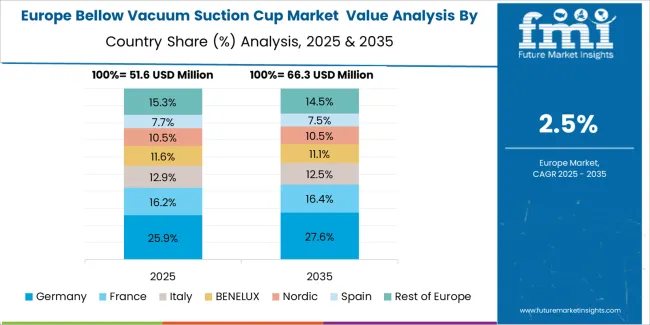
The European bellow vacuum suction cup market is projected to grow from USD 79.8 million in 2025 to USD 105.6 million by 2035, registering a CAGR of 2.9% over the forecast period. Germany is expected to maintain its leadership position with a 38.4% market share in 2025, supported by its advanced manufacturing infrastructure and major automotive production centers.
United Kingdom follows with a 19.7% share in 2025, driven by comprehensive manufacturing programs and automation technology development initiatives. France holds a 17.2% share through specialized automotive applications and electronics manufacturing requirements. Italy commands a 13.8% share, while Spain accounts for 11.0% in 2025. The rest of Europe region is anticipated to gain momentum, expanding its collective share from 6.4% to 7.2% by 2035, attributed to increasing automation adoption in Nordic countries and emerging Central European manufacturing facilities implementing industrial modernization programs.

Japan maintains established market position with 2.1% growth rate through comprehensive manufacturing programs and advanced automation infrastructure, integrating bellow vacuum suction cups across automotive facilities in Toyota City, electronics production in Tokyo, and precision manufacturing operations throughout industrial regions. The market demonstrates mature adoption patterns with 88% penetration rate in automated manufacturing facilities, supported by established quality standards and precision engineering culture. Japanese manufacturers emphasize system precision and reliability capabilities, creating demand for high-performance solutions with advanced features including sensor integration and specialized material compounds. Manufacturing operators prioritize vacuum systems that provide exceptional consistency with existing automation infrastructure and maintain strict quality standards suitable for Japanese production requirements.

South Korea demonstrates technology innovation leadership with 2.4% growth rate through advanced manufacturing automation and comprehensive industrial technology development, particularly in automotive assembly operations and electronics production facilities where companies implement cutting-edge vacuum handling systems. The market benefits from high automation adoption rates and established robotics infrastructure, enabling rapid deployment of advanced handling solutions with 84% robotic integration prevalence. Korean manufacturers integrate smart sensing capabilities and predictive maintenance features, creating distinctive handling systems that appeal to technology-forward manufacturing environments. Government support for industrial automation initiatives and smart factory programs drives continued vacuum system adoption across diverse manufacturing sectors.
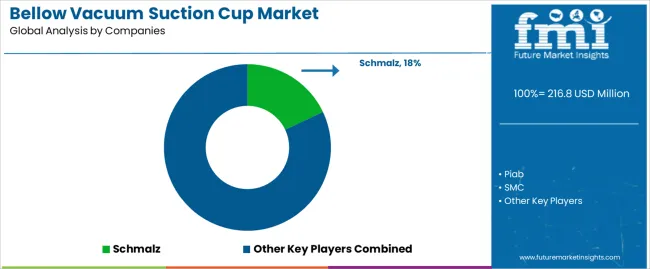
The bellow vacuum suction cup market structure consists of 15-20 credible manufacturers with the top 5-6 companies controlling approximately 65-70% of market revenue. Leadership positions are maintained through application engineering expertise, comprehensive product portfolios, and continuous material innovation encompassing compound development, performance optimization, and seamless integration with automation systems. Standard bellow designs and basic material formulations are becoming commoditized offerings as market maturity increases.
Margin opportunities concentrate in application-specific solutions, custom material compounds, and deep integration into customer automation workflows including robotic systems, handling equipment, and production line configurations. Long-term supply agreements with major automation integrators and OEM partnerships provide stable revenue streams, while value-added engineering services including application testing, performance validation, and optimization consulting create differentiation opportunities beyond standard product sales.
Manufacturers pursuing growth strategies emphasize vertical specialization into specific industry segments including automotive assembly, electronics manufacturing, and food packaging operations. Strategic partnerships with robotic system providers, vacuum generator manufacturers, and automation integrators enable comprehensive handling solutions that address complete material handling requirements. Technology investments focus on smart sensing capabilities for condition monitoring, advanced material compounds for specialized applications, and modular designs for rapid changeover scenarios.
| Stakeholder | What they actually control | Typical strengths | Typical blind spots |
|---|---|---|---|
| Global platforms | Distribution networks, product breadth, technical documentation | Wide availability, proven reliability, comprehensive catalogs | Innovation speed; application customization |
| Technology innovators | Material R&D; sensor integration; advanced compounds | Latest materials first; performance leadership | Service density outside core markets; price positioning |
| Regional specialists | Local engineering, fast delivery, nearby support | Market knowledge; practical solutions; responsive service | Technology gaps; limited material options |
| Application-focused providers | Industry expertise, turnkey solutions, engineering support | Lowest application risk; comprehensive validation | Standardization limits; narrow market focus |
| OEM partners | System integration, bundled offerings, automation compatibility | Seamless integration; one-stop solutions | Component flexibility; aftermarket presence |
| Item | Value |
|---|---|
| Quantitative Units | USD million |
| Material Type | Nitrile Suction Cup, Silicone Suction Cup, Others |
| Application | Automotive, Electronics, Packaging, Others |
| Regions Covered | North America, Latin America, Western Europe, Eastern Europe, East Asia, South Asia Pacific, Middle East & Africa |
| Countries Covered | United States, China, Germany, India, United Kingdom, Japan, Canada, Brazil, France, Australia, South Korea, and 22+ additional countries |
| Key Companies Profiled | Schmalz, Piab, SMC, Coval, FIPA, VacMotion, ANVER, Pisco, AIRBEST, EuroTECH |
| Additional Attributes | Revenue analysis by material type and application categories, regional adoption trends across East Asia, South Asia Pacific, and Western Europe, competitive landscape with vacuum technology manufacturers and automation equipment suppliers, manufacturing operator preferences for material durability and system reliability, integration with robotic platforms and automation systems, innovations in material compounds and performance enhancement, and development of sensor-enabled solutions with predictive capabilities and manufacturing optimization features. |
The global bellow vacuum suction cup market is estimated to be valued at USD 216.8 million in 2025.
The market size for the bellow vacuum suction cup market is projected to reach USD 285.8 million by 2035.
The bellow vacuum suction cup market is expected to grow at a 2.8% CAGR between 2025 and 2035.
The key product types in bellow vacuum suction cup market are nitrile suction cup, silicone suction cup and others.
In terms of application, automotive segment to command 35.0% share in the bellow vacuum suction cup market in 2025.






Full Research Suite comprises of:
Market outlook & trends analysis
Interviews & case studies
Strategic recommendations
Vendor profiles & capabilities analysis
5-year forecasts
8 regions and 60+ country-level data splits
Market segment data splits
12 months of continuous data updates
DELIVERED AS:
PDF EXCEL ONLINE
Bus Bellows Market Insights – Growth & Forecast 2025 to 2035
Metal Bellow Market Size and Share Forecast Outlook 2025 to 2035
Vacuum Fiber Feedthrough Flanges Market Size and Share Forecast Outlook 2025 to 2035
Vacuum Tension Rolls Market Size and Share Forecast Outlook 2025 to 2035
Vacuum Self-priming Mobile Pumping Station Market Size and Share Forecast Outlook 2025 to 2035
Vacuum Skin Packaging Market Size and Share Forecast Outlook 2025 to 2035
Vacuum-Refill Units Market Analysis - Size and Share Forecast Outlook 2025 to 2035
Vacuum Leak Detectors Market Size and Share Forecast Outlook 2025 to 2035
Vacuum Insulation Panels Market Size and Share Forecast Outlook 2025 to 2035
Vacuum Pressure Encapsulated Transformer Market Size and Share Forecast Outlook 2025 to 2035
Vacuum Insulated Medium Voltage Switchgear Market Size and Share Forecast Outlook 2025 to 2035
Vacuum Rated Motors Market Size and Share Forecast Outlook 2025 to 2035
Vacuum Concentrators Market Size and Share Forecast Outlook 2025 to 2035
Vacuum Insulated Low Voltage Commercial Switchgear Market Size and Share Forecast Outlook 2025 to 2035
Vacuum Pressure Impregnated (VPI) Transformer Market Size and Share Forecast Outlook 2025 to 2035
Vacuum Insulated Pipe Market Size and Share Forecast Outlook 2025 to 2035
Vacuum Therapy Devices Market Size and Share Forecast Outlook 2025 to 2035
Vacuum Pressure Swing Adsorption Market Size and Share Forecast Outlook 2025 to 2035
Vacuum Grease Market Size and Share Forecast Outlook 2025 to 2035
Vacuum Truck Market Size and Share Forecast Outlook 2025 to 2035

Thank you!
You will receive an email from our Business Development Manager. Please be sure to check your SPAM/JUNK folder too.
Chat With
MaRIA